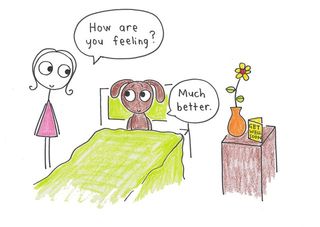Anxiety
How to Measure Improvement in Psychotherapy: 5 Approaches
What counts as improvement, and knowing when done is done?
Posted May 5, 2019

Private practitioners have overwhelmingly refused to implement evidence-based treatments such as cognitive behavioral therapy (CBT) (Miron & Scheeringa, in press). In the gospels of private practice, one of the reasons that private practitioners give for why CBT cannot or should not be implemented is that CBT is not an appropriate treatment for the types of outcomes patients are seeking. Private practitioners often claim that what works in research studies is therefore inappropriate for private practice.
For private practitioners to make the big lift and spend their time on training in CBT and invest their energy into following full CBT protocols with fidelity, they have to be convinced that better patient outcomes are within reach with CBT. But for that to happen, McHugh and Barlow (2010) noted that patient outcomes have to be tracked. However, private practitioners rarely track patient outcomes with any metrics of their own. The informal “I-know-improvement-when-I-see-it” approach of private practice may work for many individual patients, but fails to provide a cumulative body of knowledge for patients who are trying to shop between psychotherapy approaches. Without data, all they have are hearsay, anecdotes and unsupported speculations.
Without such basic metrics as patient outcomes, examinations cannot begin to explore mediators of successful adoption, the best sustainability models, or ways to address the highly variable rates at which clinicians adopt EBTs (Rosen et al., 2015). But what is the best way to track outcome?
Five ways to track outcomes
(1) Symptom reduction is the simplest and most straightforward outcome to track. For example, a patient with an anxiety disorder can complete a 20-item Zung Anxiety Scale at the beginning of treatment. Each item is scored on a 1-4 point scale, so the range of possible scores is 20-80. At the beginning of treatment they score 60. After three months of psychotherapy, they complete the scale again and this time they score 30. They have achieved a 50% symptom reduction, which, in our business, is an excellent outcome.
Symptom reduction has advantages as a simple and straightforward metric, but it has a disadvantage of not indicating whether someone still has the disorder or not. For example, a patient who begins treatment with extremely high severity may improve 40% but still have enough symptoms to qualify for the disorder.
(2) Remission of disorder is a way to track outcome that indicates whether patients have the disorder or not. Remission is tracked as a categorical yes/no outcome. If a patient meets all the criteria for a disorder, he or she is classified as “yes, has the disorder.” If a patient has some symptoms of the disorder, but not all of the necessary criteria, he or she is classified as “no, does not have the disorder.”
Remission provides a different dimension compared to symptom reduction, however, this method too has its drawbacks. In an extreme, but possible, example, a patient can start treatment with the disorder, and improve on only one symptom so that they no longer qualify for the disorder. But they may have improved in terms of symptom reduction by only 10%.
(3) Recognizing the limitations of both the symptom reduction and the remission methods, researchers have invented a host of more complicated metrics. One of these metrics is called the Reliable Change Index (Jacobson & Truax, 1991). The creators of the Index and critics have noted several drawbacks of this approach. In order to calculate a reliable change index, one has to know the average score of the outcome measure in the general population (that is, a non-clinical sample), which is not known for most measures. Also, the reliable change index is meant to indicate when patients have returned to normal function, which is an unrealistic expectation for most of the population of help-seeking individuals. A third drawback is that calculation of the index involves more than simple math computations, which, realistically, is not feasible for most practitioners.
(4) Functional impairment is yet another way to track outcomes. In my clinics, symptom reduction is how we mainly track outcomes, and we’ve found, somewhat surprisingly, that even patients who achieve only 10-30% symptom reduction are generally satisfied with their treatments. Because of this, we added a measure to track functional impairment, which tracks their ability to perform their daily functions independent of whether they have symptoms. What we tend to find is that the patients with minimal symptom reduction in the 10-30% range, are also experiencing improvements in their functional impairment scores, and that may explain why patients are satisfied with their progress.
(5) We’re also starting to experiment with a new measure I invented called the Tipping Point measure, which is 25 questions about why patients decided to call for help in the first place. This type of measure may be more salient for a patient who had moderate anxiety symptoms for 20 years but finally decided to ask for help because they had their first panic attack and went to the emergency room. Or, a different patient may have not have high level of symptoms of any disorder but is trying to sort out their options of moving to a new city and starting a different career.
In summary, the point is that there are many different ways to track outcomes of psychotherapy and each has its pros and cons, and all of them probably have some value for all patients, but it would be difficult for most clinicians to track all of them. Plus, it would be overwhelming visually for all but the biggest data nerds. Fortunately, all of these tracking methods can be digital, and digital data visualization methods opens up a whole world of different ways to analyze and visually represent outcomes to patients. We’re working on creating a consumer-friendly dashboard to do that. Creation of the dashboard is expensive and time-consuming, but moving forward on this seems critical if we’re ever going to move the ball forward on improving the quality of the psychotherapy experience for consumers.
References
Jacobson, N.S., & Truax, P. (1991). Clinical significance: a statistical approach to defining meaningful change in psychotherapy research. Journal of Consulting and Clinical Psychology, 59(1), 12-19.
McHugh, R.K., & Barlow, D.H. (2010). The dissemination and implementation of evidence-based psychological treatments: A review of current efforts. American Psychologist, 65(2):73-84.
Miron D, Scheeringa, MS (in press). A Statewide Training of Community Clinicians to Treat Traumatized Youths Involved with Child Welfare. Psychological Services 16(1), 153-161, doi 10.1037/ser0000317.
Rosen, C.S., Matthieu, M.M., Wiltsey Stirman, S. et al., (2016). A review of studies on the system-wide implementation of evidence-based psychotherapies for posttraumatic stress disorder in the Veterans Health Administration. Administration and Policy in Mental Health, 43:957-977.




